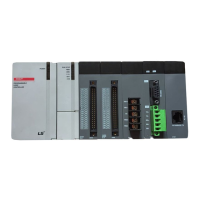Chapter 5 Memory and Parameter
(b) PDO settings
RxPDO sets the synchronous data which is transmitted from the motion controller to the slave in every communication cycle.
The RxPDO items supported by the relevant slave are automatically set when selecting the slave. You can use the ‘Edit’
function to add or delete objects you want.
For the slave used as the motion axis, when editing the RxPDO object, the following objectives must be included as they
are essential items used in the motion control module.
0x6040:0 Controlword
The synchronous data allocated here is automatically assigned to I/O devices and it can be registered as I/O variables and
referred in the user program. For example, the ‘Controlworld’ object of RxPDO synchronous data of L7N servo drive
connected to the slave 1 is registered as I/O flag Rx1_1_0_ControlWord (%QW64).
TxPDO sets the synchronous data read from the slave of the motion controller in every communication cycle. When selecting
the slave, the TxPDO items supported by the relevant slave are set automatically. You can use the ‘Edit’ function to add or
delete objects you want.
When editing the PDO object, the following objects must be included as they are essential items used in the motion control
module.
For the slave used as the motion axis, when editing the TxPDO object, the following objectives must be included as they
are essential items used in the motion control module.
0x6041:0 Statusword
The synchronous data allocated here is automatically assigned to I/O devices and it can be registered as I/O variables and
referred in the user program. For example, the‘‘Statusword’ object of TxPDO synchronous data of L7N servo drive connected
to the slave 2 is registered as I/O flag Tx_1_2_0_StatusWord(%IW68).
(c) SDO parameters
- Set the SDO (Service Data Object) parameters operated in the slave.
- The parameters are not stored on the motion controller but are operated on the slave.
- For the setting and operation of the parameters, refer to the Appendix 3 Setting Example.

